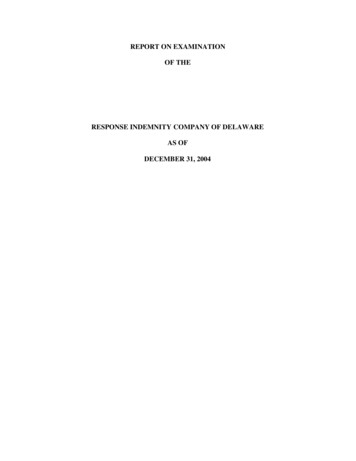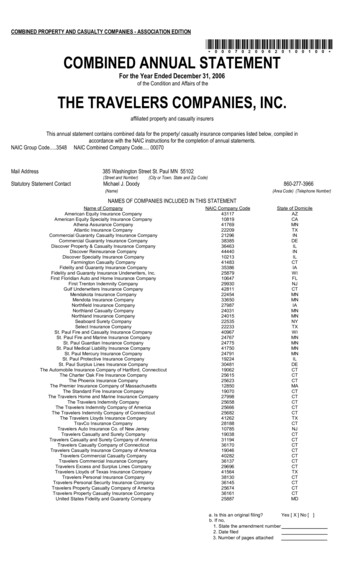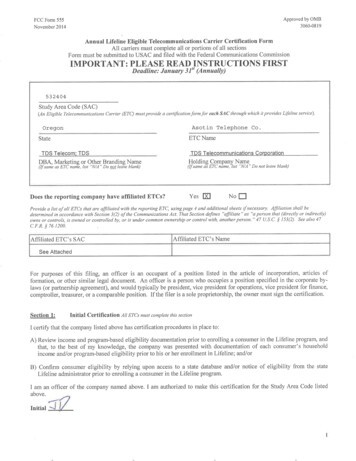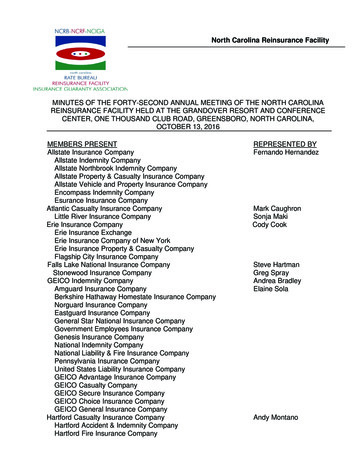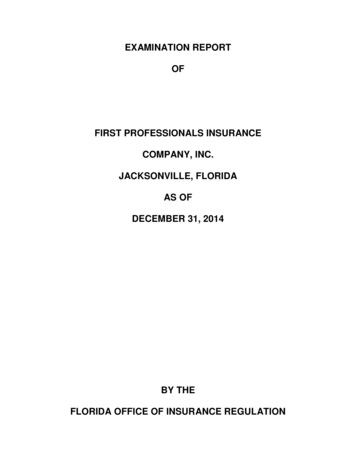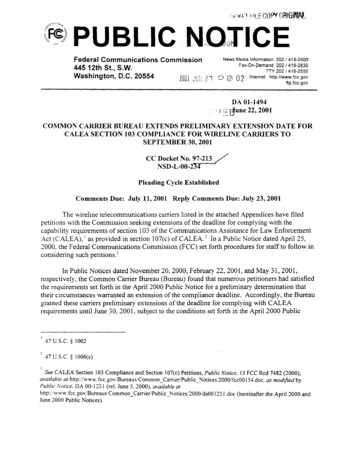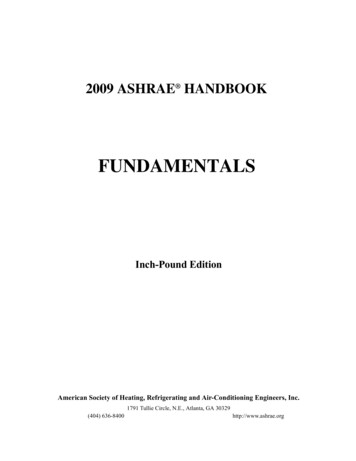
Transcription
2009 ASHRAE HANDBOOKFUNDAMENTALSInch-Pound EditionAmerican Society of Heating, Refrigerating and Air-Conditioning Engineers, Inc.1791 Tullie Circle, N.E., Atlanta, GA 30329(404) 636-8400http://www.ashrae.org
2009 by the American Society of Heating, Refrigerating and Air-Conditioning Engineers,Inc. All rights reserved.DEDICATED TO THE ADVANCEMENT OFTHE PROFESSION AND ITS ALLIED INDUSTRIESNo part of this publication may be reproduced without permission in writing fromASHRAE, except by a reviewer who may quote brief passages or reproduce illustrations ina review with appropriate credit; nor may any part of this book be reproduced, stored in aretrieval system, or transmitted in any way or by any means—electronic, photocopying,recording, or other—without permission in writing from ASHRAE. Requests for permission should be submitted at www.ashrae.org/permissions.Volunteer members of ASHRAE Technical Committees and others compiled the information in this handbook, and it is generally reviewed and updated every four years. Comments, criticisms, and suggestions regarding the subject matter are invited. Any errors oromissions in the data should be brought to the attention of the Editor. Additions and corrections to Handbook volumes in print will be published in the Handbook published the yearfollowing their verification and, as soon as verified, on the ASHRAE Internet Web site.DISCLAIMERASHRAE has compiled this publication with care, but ASHRAE has not investigated,and ASHRAE expressly disclaims any duty to investigate, any product, service, process,procedure, design, or the like that may be described herein. The appearance of any technicaldata or editorial material in this publication does not constitute endorsement, warranty, orguaranty by ASHRAE of any product, service, process, procedure, design, or the like.ASHRAE does not warrant that the information in this publication is free of errors. Theentire risk of the use of any information in this publication is assumed by the user.ISBN 978-1-933742-54-0ISSN 1523-7222The paper for this book is both acid- and elemental-chlorine-free and wasmanufactured with pulp obtained from sources using sustainable forestrypractices. The printing used soy-based inks.
ASHRAE Research: Improving the Quality of LifeThe American Society of Heating, Refrigerating and AirConditioning Engineers is the world’s foremost technical society inthe fields of heating, ventilation, air conditioning, and refrigeration.Its members worldwide are individuals who share ideas, identifyneeds, support research, and write the industry’s standards for testing and practice. The result is that engineers are better able to keepindoor environments safe and productive while protecting and preserving the outdoors for generations to come.One of the ways that ASHRAE supports its members’ and industry’s need for information is through ASHRAE Research. Thousands of individuals and companies support ASHRAE Researchannually, enabling ASHRAE to report new data about materialproperties and building physics and to promote the application ofinnovative technologies.Chapters in the ASHRAE Handbook are updated through theexperience of members of ASHRAE Technical Committees andthrough results of ASHRAE Research reported at ASHRAE meetings and published in ASHRAE special publications and inASHRAE Transactions.For information about ASHRAE Research or to become a member, contact ASHRAE, 1791 Tullie Circle, Atlanta, GA 30329; telephone: 404-636-8400; www.ashrae.org.PrefaceThe 2009 ASHRAE Handbook—Fundamentals covers basic principles and data used in the HVAC&R industry. The ASHRAE Technical Committees that prepare these chapters strive not only toprovide new information, but also to clarify existing information,delete obsolete materials, and reorganize chapters to make the Handbook more understandable and easier to use. An accompanying CDROM contains all the volume’s chapters in both I-P and SI units.This edition includes a new chapter (35), Sustainability, whichdefines this concept for HVAC&R and describes the principles,design considerations, and detailed evaluations needed in designingsustainable HVAC&R systems.Also new for this volume, chapter order and groupings have beenrevised for more logical flow and use. Some of the other revisionsand additions to the volume are as follows: Chapter 1, Psychrometrics, has new information on the composition of dry air, and revised table data for thermodynamic properties of water and moist air. Chapter 6, Mass Transfer, has added examples on evaluating diffusion coefficients, and on heat transfer and moisture removal rates. Chapter 7, Fundamentals of Control, includes new content ondampers, adaptive control, direct digital control (DDC) systemarchitecture and specifications, and wireless control. Chapter 9, Thermal Comfort, has a new section on thermal comfort and task performance, based on multiple new studies done inlaboratory and office environments. Chapter 10, Indoor Environmental Health, was reorganized todescribe hazard sources, health effects, exposure standards, andexposure controls. New and updated topics include mold, Legionella, indoor air chemistry, thermal impacts, and water qualitystandards. Chapter 14, Climatic Design Information, has new climate datafor 5564 stations (an increase of 1142 new stations compared to2005 Fundamentals) on the CD-ROM accompanying this book.A subset of data for selected stations is also included in theprinted chapter for convenient access. Chapter 15, Fenestration, has been revised to include new examples of solar heat gain coefficient (SHGC) calculations, and newresearch results on shading calculations and U-factors for variousspecialized door types. Chapter 16, Ventilation and Infiltration, has new, detailed examples, updates from ASHRAE Standards 62.1 and 62.2, discussionof relevant LEED aspects, and new information on airtightnessand ventilation rates for commercial buildings. Chapter 18, Nonresidential Cooling and Heating Load Calculations, has been updated to reflect new ASHRAE research resultson climate data and on heat gains from office equipment, lighting,and commercial cooking appliances. Chapter 20, Space Air Diffusion, has been completely rewritten toharmonize with related chapters in other volumes, with major sections on fully mixed, partially mixed, stratified, and task/ambientsystems and the principles behind their design and operation. Chapter 21, Duct Design, has new data for round and rectangularfittings in agreement with the ASHRAE Duct Fitting Database, aswell as new content on duct leakage requirements, spiral ductroughness, and flexible duct pressure loss correction. Chapter 23, Insulation for Mechanical Systems, has added tablesfrom ASHRAE Standard 90.1-2007, and a new section on writingspecifications. Chapter 24, Airflow Around Buildings, has added a detailed discussion on computational evaluation of airflow, plus new references including updated versions of design standards andmanuals of practice. Chapters 25, 26, and 27 carry new titles, reorganized as chapterson Heat, Air, and Moisture Control Fundamentals, Material Properties, and Examples, respectively, with updated content throughout. Chapter 29, Refrigerants, has new content on stratospheric ozonedepletion, global climate change, and global environmental characteristics of refrigerants. Chapter 30, Thermophysical Properties of Refrigerants, has updated data for R-125, R-245fa, R-170, R-290, R-600, and R-600a. Chapter 36, Measurement and Instruments, has revised content onmeasurement of air velocity, infiltration, airtightness, and outdoorair ventilation, plus new information on particle image velocimetry (PIV) and data acquisition and recording.This volume is published, both as a bound print volume and inelectronic format on a CD-ROM, in two editions: one using inchpound (I-P) units of measurement, the other using the InternationalSystem of Units (SI).Corrections to the 2006, 2007, and 2008 Handbook volumes canbe found on the ASHRAE Web site at http://www.ashrae.org and inthe Additions and Corrections section of this volume. Correctionsfor this volume will be listed in subsequent volumes and on theASHRAE Web site.Reader comments are enthusiastically invited. To suggest improvements for a chapter, please comment using the form on theASHRAE Web site or, using the cutout page(s) at the end of this volume’s index, write to Handbook Editor, ASHRAE, 1791 Tullie Circle, Atlanta, GA 30329, or fax 678-539-2187, or e-mail mowen@ashrae.org.Mark S. OwenEditor
The four-volume ASHRAE Handbook is a reference for engineers working in HVAC&R and for professionals in allied fields. The print edition isrevised on a four-year cycle, with one volume published each year. Tables of contents for the four most recent volumes appear on these pages, and acomposite index is at the end of this volume. In addition to the CD-ROM accompanying this book, ASHRAE publishes a HandbookCD containingall four volumes plus supplemental material and features. The Society also produces educational materials, standards, design guides, databases, andmany other useful publications. See the online bookstore of the ASHRAE Web site (www.ashrae.org) for information on these publications.2009 rometricsThermodynamics and Refrigeration CyclesFluid FlowHeat TransferTwo-Phase FlowMass TransferFundamentals of ControlSound and VibrationINDOOR ENVIRONMENTAL QUALITYChapter9.10.11.12.13.Thermal ComfortIndoor Environmental HealthAir ContaminantsOdorsIndoor Environmental ModelingLOAD AND ENERGY CALCULATIONSChapter 14.15.16.17.18.19.Climatic Design InformationFenestrationVentilation and InfiltrationResidential Cooling and Heating Load CalculationsNonresidential Cooling and Heating LoadCalculationsEnergy Estimating and Modeling MethodsHVAC DESIGNChapter 20.Space Air Diffusion21.22.23.24.Duct DesignPipe SizingInsulation for Mechanical SystemsAirflow Around BuildingsBUILDING ENVELOPEChapter 25.26.27.Heat, Air, and Moisture Control in BuildingAssemblies—FundamentalsHeat, Air, and Moisture Control in BuildingAssemblies—Material PropertiesHeat, Air, and Moisture Control in BuildingAssemblies—ExamplesMATERIALSChapter 28.29.30.31.32.33.Combustion and FuelsRefrigerantsThermophysical Properties of RefrigerantsPhysical Properties of Secondary Coolants (Brines)Sorbents and DesiccantsPhysical Properties of MaterialsGENERALChapter 34.35.36.37.38.39.Energy ResourcesSustainabilityMeasurement and InstrumentsAbbreviations and SymbolsUnits and ConversionsCodes and Standards2008 HVAC SYSTEMS AND EQUIPMENTAIR-CONDITIONING AND HEATING SYSTEMSHEATING EQUIPMENT AND COMPONENTSChapterChapter .14.15.16.17.HVAC System Analysis and SelectionDecentralized Cooling and HeatingCentral Heating and CoolingAir Handling and DistributionIn-Room Terminal SystemsPanel Heating and CoolingCombined Heat and Power SystemsApplied Heat Pump and Heat Recovery SystemsSmall Forced-Air Heating and Cooling SystemsSteam SystemsDistrict Heating and CoolingHydronic Heating and CoolingCondenser Water SystemsMedium- and High-Temperature Water HeatingInfrared Radiant HeatingUltraviolet Lamp SystemsCombustion Turbine Inlet CoolingAIR-HANDLING EQUIPMENT AND COMPONENTSChapter 18.19.20.21.22.23.24.25.26.27.28.29.Duct ConstructionRoom Air Distribution EquipmentFansHumidifiersAir-Cooling and Dehumidifying CoilsDesiccant Dehumidification and Pressure-DryingEquipmentMechanical Dehumidifiers and Related ComponentsAir-to-Air Energy Recovery EquipmentAir-Heating CoilsUnit Ventilators, Unit Heaters, and Makeup AirUnitsAir Cleaners for Particulate ContaminantsIndustrial Gas Cleaning and Air Pollution ControlEquipmentAutomatic Fuel-Burning SystemsBoilersFurnacesResidential In-Space Heating EquipmentChimney, Vent, and Fireplace SystemsHydronic Heat-Distributing Units and RadiatorsSolar Energy EquipmentCOOLING EQUIPMENT AND COMPONENTSChapter 37.38.39.40.41.42.CompressorsCondensersCooling TowersEvaporative Air-Cooling EquipmentLiquid CoolersLiquid-Chilling SystemsGENERAL COMPONENTSChapter 43.44.45.46.47.Centrifugal PumpsMotors, Motor Controls, and Variable-Speed DrivesPipes, Tubes, and FittingsValvesHeat ExchangersPACKAGED, UNITARY, AND SPLIT-SYSTEMEQUIPMENTChapter 48.49.Unitary Air Conditioners and Heat PumpsRoom Air Conditioners and Packaged Terminal AirConditionersGENERALChapter 50.51.Thermal StorageCodes and Standards
CD-ROM with all content from 2009 Fundamentals inside back cover2007 HVAC APPLICATIONSCOMFORT APPLICATIONSENERGY-RELATED APPLICATIONSChapterChapter 32.33.34.1.2.3.4.5.6.7.8.9.10.11.ResidencesRetail FacilitiesCommercial and Public BuildingsPlaces of AssemblyHotels, Motels, and DormitoriesEducational FacilitiesHealth Care FacilitiesJustice FacilitiesAutomobiles and Mass TransitAircraftShipsINDUSTRIAL APPLICATIONSChapter .29.30.31.Industrial Air ConditioningEnclosed Vehicular FacilitiesLaboratoriesEngine Test FacilitiesClean SpacesData Processing and Electronic Office AreasPrinting PlantsTextile Processing PlantsPhotographic Material FacilitiesMuseums, Galleries, Archives, and LibrariesEnvironmental Control for Animals and PlantsDrying and Storing Selected Farm CropsAir Conditioning of Wood and Paper ProductFacilitiesPower PlantsNuclear FacilitiesMine Air Conditioning and VentilationIndustrial Drying SystemsVentilation of the Industrial EnvironmentIndustrial Local Exhaust SystemsKitchen VentilationGeothermal EnergySolar Energy UseThermal StorageBUILDING OPERATIONS AND MANAGEMENTChapter 35.36.37.38.39.40.41.42.Energy Use and ManagementOwning and Operating CostsTesting, Adjusting, and BalancingOperation and Maintenance ManagementComputer ApplicationsBuilding Energy MonitoringSupervisory Control Strategies and OptimizationHVAC CommissioningGENERAL APPLICATIONSChapter .Building E
Chapters in the ASHRAE Handbook are updated through the experience of members of ASHRAE Technical Committees and through results of ASHRAE Research reported at ASHRAE meet- ings and published in ASHRAE special publications and in ASHRAE Transactions. For information about ASHRAE Research or to become a mem-ber, contact ASHRAE, 1791 Tullie Circle, Atlanta, GA 30329; tele


